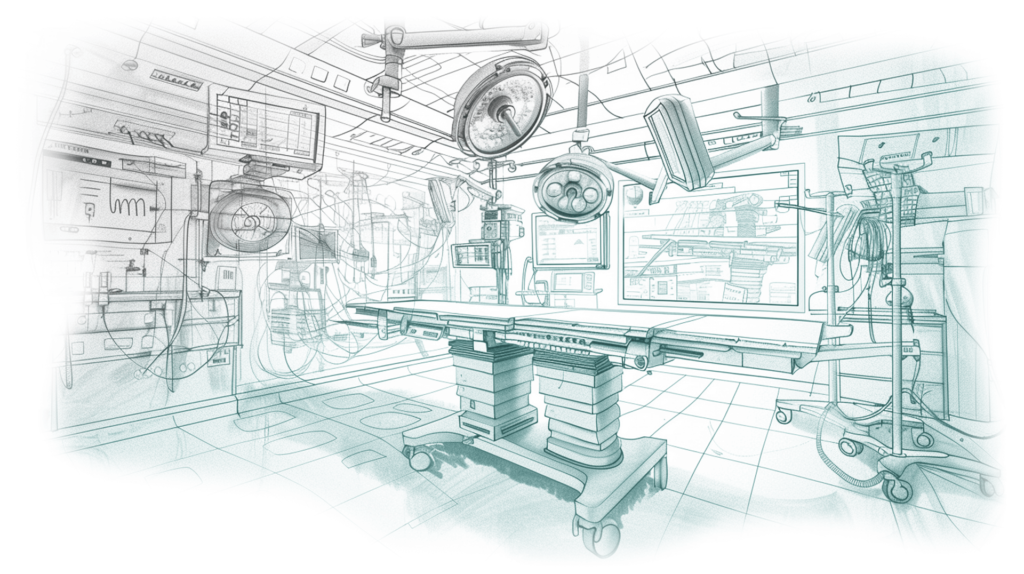| Client | A manufacturer of solutions for operating rooms |
| Goals |
|
| Scope of work | |
| Duration | 24 months+ |
| Team |
|
| Outcomes | A comprehensive and functional operating room management system with a modular infrastructure offering full integration of medical and non-medical devices and advanced medical image management features. |
| Technologies | .Net, JavaScript, Windows Presentation Foundation (WPF) |
Client background
Our client designs, manufactures, and installs innovative solutions for operating rooms, hybrid operating rooms, intensive care units, and neonatal intensive care units. The company equips specialized procedure rooms and hospital wards with equipment and modular hygienic installations.
The system we worked on is a modern operating room management system designed to streamline work, improve ergonomics, and increase safety in the operating room. It provides integration of medical and non-medical equipment and advanced image management functions.
Key features of the solution
Modularity:
- One control panel with three segments
User interface:
- Usable interface with dark and light modes
Control of medical devices:
- Operating lights
- Operating tables
- Visualization and monitoring of medical gas status
Control of non-medical devices:
- Automatic doors and blinds
- Ventilation and air conditioning system
- General lighting
- Music player
Image management:
- Management of video images in the operating room, video conferencing
- Ability to connect multiple video sources
Process
Our collaboration began with a needs analysis process, which allowed us to jointly select optimal solutions. Ideas that emerged during the analysis were often refined in joint sessions to maximize their potential.
After the analysis phase, we moved to the development stage. The challenge here was the integration with medical equipment, which, due to the complexity of communication protocols, required special attention and often an unconventional approach.
The company needed support in developing an application based on Microsoft solutions (WPF) to offer their clients worldwide comprehensive solutions for managing operating rooms. Given the ambitious development plans for this area, it was crucial to build an application that ensures the possibility of rapid and flexible expansion with additional components and integration with new models of devices.
Solution
Foundation of modern surgery
Operating room integration systems are gaining popularity worldwide, and the market for these solutions is growing dynamically. In 2023, the global market value of operating room integration systems was approximately USD 2.1 billion, and it is expected to reach USD 3.7 billion by 2028, representing an annual growth rate of 12.1%.
The largest regional markets are North America, Europe, and Asia-Pacific. In Europe, the leaders are the United Kingdom, Germany, and France, with particularly rapid growth in Germany. In the Asia-Pacific region, China and India are experiencing the highest growth, driven by the increasing number of surgical procedures and improving medical infrastructure.
These systems are key to improving operational efficiency, patient safety, and enabling advanced medical image management, which is particularly important in the face of the growing number of complex operations and minimally invasive surgical procedures.
Optimal solution for enhancing safety
Regarding lighting, it is crucial to adjust it to the phase of the operation. The technology used by our client allows for various lighting scenarios. However, it was necessary to develop a panel that allows easy control of this solution. The UI of the control panels provided by the light manufacturers corresponded to the physical layout of the buttons on the lamp. Our task was to replicate it with extremely high precision, so the medical staff would not have to learn a new button layout.
As a result, medical staff can easily choose the lighting mode of the operating room to rest the eyes of the surgeon performing the operation while saving energy by reducing the lighting intensity during idle periods.
Open architecture
It was important to ensure that the system would be flexible in terms of integration with new operating room equipment and adapted to future solutions (hence, among others, the need to ensure compatibility with 4K and 3D technologies). It was also crucial to maintain the ability to quickly implement new functionalities.
In terms of software, it was essential to create a solution with an open architecture to facilitate system expansion with additional devices subject to integration.
Continuous development
The solution is continuously evolving, and the SEDIVIO team is involved in the project.
The company commits to its clients – medical facilities – to provide comprehensive support services, including software updates. This is a necessary condition to ensure the highest quality of the foundation of high-quality surgical services, which are the systems for integrating devices used in operating rooms.
Data sources
- https://www.mordorintelligence.com/industry-reports/operating-room-integration
- https://www.marketsandmarkets.com/Market-Reports/operating-room-integration-market-160774667.html
- https://www.researchandmarkets.com/reports/5901472/operating-room-integration-market-global
- https://www.marketresearchfuture.com/reports/operating-room-integration-systems-market-11596)
- https://www.globenewswire.com/en/news-release/2024/03/19/2848849/28124/en/The-Global-Operating-Room-Integration-Systems-Market-Emerging-Trends-and-Regulatory-Dynamics-to-2033-Featuring-Stryker-Steris-Olympus-Hill-Rom-and-Getinge.html



